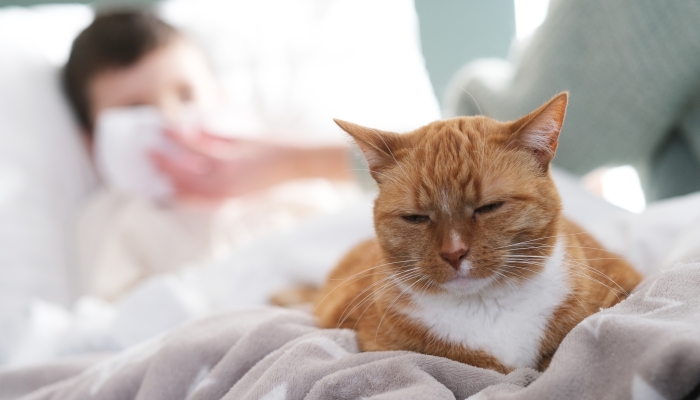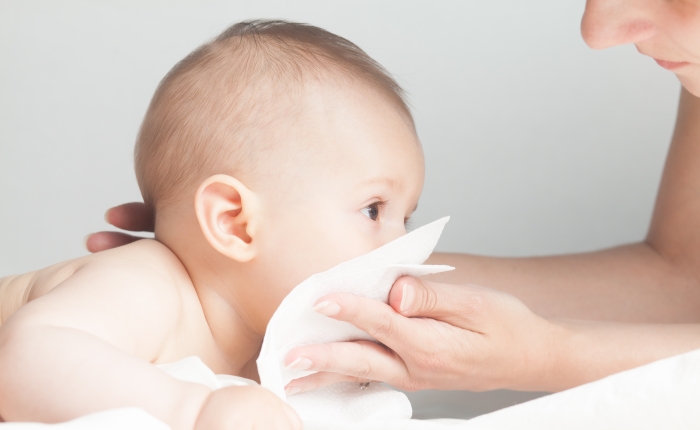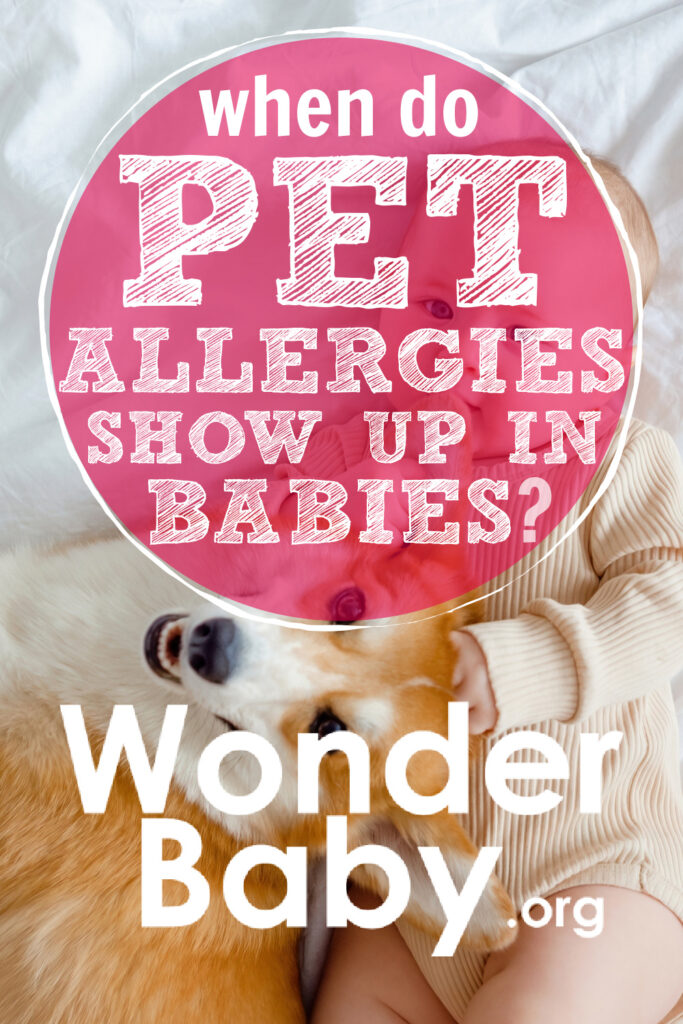When Do Pet Allergies Show Up in Babies?

- Pet allergens can cause allergic reaction symptoms in young children.
- Severe allergic reactions to pets, though rare, can occur.
- Diagnosis of specific allergies should be made by a healthcare professional.
- There are medications and strategies available to manage pet allergen exposure.
Before I had children, I had cozy dreams of my little ones romping on the floor with our dogs and family pets. My baby might plague our pets or be covered in cat saliva or dog’s fur, but the loving bond between child and pet would make it all worth it—and I’d have the ultimate photo for holiday cards.
Fast forward to actually having children and pets: It looked nothing like my cozy visions. Our dog didn’t react well to having babies in the house, and the kids, for their part, were miserable. There was so much fur that constantly attached itself to my baby’s clothes, and my little ones had eternal runny noses and red eyes.
I began to wonder if my children were experiencing pet allergies, even though they were very young. If they were indeed having an allergic reaction, how could I manage their symptoms without getting rid of our family pets?
Turns out, there are many ways you can manage an animal allergy at home—and you may not have to give away your pets to do it!
Pet Allergies in Babies: What Parents Need to Know

When it comes to allergic reactions, there’s much more involved than just a simple case of sniffles.
What are Pet Allergies?
Pet allergy symptoms are caused by an immune response to the animal’s dander11. James, J.. Pet allergy. Asthma & Allergy Foundation of America. 2022. https://aafa.org/allergies/types-of-allergies/pet-dog-cat-allergies (dead skin cells). Pet dander allergies can also be caused by exposure to the offending animal’s saliva or urine.
Your baby’s immune system sees these allergens as potential threats to the body and activates a complex chemical reaction22. Peavy, R. D., & Metcalfe, D. D.. Understanding the mechanisms of anaphylaxis. Current Opinion in Allergy & Clinical Immunology. 2008;8(4), 310–315. https://doi.org/10.1097/aci.0b013e3283036a90 to respond.
Over time, and with repeated exposure, what began as only a mild reaction can progress to more pronounced symptoms that can impact your child’s health and lead to other allergy-related diseases.
How Common Are Pet Allergies in Babies?
Dogs, cats, and other animals are popular household pets. According to the World Animal Foundation33. Martyn, M.. Pet Ownership Statistics – Inspiring You To Bring Home Your Next Best Friend! World Animal Foundation (WAF). 2023. https://worldanimalfoundation.org/advocate/pet-ownership-statistics in 2022, 70% of American households owned a pet, with dogs being the first most popular pet at 69%, followed by cats (45.3%), and freshwater fish (11.8%).
Researchers Chan and Leung in their 2018 study entitled “Dog and Cat Allergies: Current State of Diagnostic Approaches and Challenges”44. Chan, S. K., & Leung, D. Y.. Dog and Cat Allergies: Current State of Diagnostic Approaches and Challenges. Allergy, Asthma & Immunology Research. 2018;10(2), 97. https://doi.org/10.4168/aair.2018.10.2.97 published in Allergy, Asthma, & Immunology Research, report that “allergies to dogs and cats affect 10%–20% of the population worldwide and is a growing public health concern as these rates increase.”
Given the popularity of a dog or cat serving as a family pet, there are many instances where exposure to the family’s furry friend can trigger allergic reactions among all members of the family.
Do Pet Allergies in Babies Cause Life-Threatening Conditions?
While possible, a severe allergic reaction to pet dander tends to be relatively rare.
Pet hair, whether on the animal or the floor, tends to trap substances that can trigger allergies and more pronounced allergic reactions in affected people of all ages.
Common allergens trapped in your pet’s fur include:
- Dried pet saliva
- Dried skin flakes
- Dust mites
- Household allergens, like dust
- Environmental allergens, like pollen or grass
- Other animal dander (for example, having guinea pigs, cats, or dogs in the same home)
If you note that your little one’s allergy symptoms tend to flare up when they’re around certain animals, monitor your child’s condition and contact their healthcare provider with any concerns.
At What Age Do Pet Allergies Show Up in Babies?

Babies who are predisposed to cat allergies or dog allergies may begin to develop an immune response before showing outward physical symptoms. In light of this fact, pet allergies may develop at any age, though you may not see symptoms until your baby is older.
According to a 2010 study by Wegienka and colleagues entitled “Indoor pet exposure and the outcomes of total IgE and sensitization at age 18 years”55. Wegienka, G., Johnson, C. C., Havstad, S., Ownby, D. R., & Zoratti, E. M.. Indoor PET exposure and the outcomes of total IGE and sensitization at age 18 years. Journal of Allergy and Clinical Immunology,. 2010;126(2). https://doi.org/10.1016/j.jaci.2010.05.001 and published in the Journal of Allergy and Clinical Immunology, “those living with pets in the first year and atopic66. Atopy defined. American Academy of Allergy Asthma & Immunology. https://www.aaaai.org/tools-for-the-public/allergy,-asthma-immunology-glossary/atopy-defined#:~:text=Atopy%20refers%20to%20the%20genetic,inhaled%20allergens%20and%20food%20allergens. at 18 years had lower total IgE levels. Early-life pet exposure can be associated with lower total IgE levels among atopic subjects but is not strongly associated with decreased likelihood of sensitization to common allergens at age 18 years.”
Restated, being around a dog or cat in the first years of life may decrease the strength of an immune response when older, but does not, statistically speaking, seem to prevent the development of allergies in a predisposed child.
How to Tell if Your Baby Is Allergic to Pets

According to experts at the Asthma and Allergy Foundation of America, animal allergy symptoms occur when animal allergens come in contact with an affected person’s mucus membranes (soft tissues) that line the eyes and nose.
Common and more serious symptoms of allergies (such as anaphylaxis77. Tupper, J., & Visser, S.. Anaphylaxis: A review and update. Canadian family physician Medecin de famille canadien. 2010;56(10), 1009–1011. https://pubmed.ncbi.nlm.nih.gov/20944042) include:
| Common symptoms | Severe symptoms (anaphylaxis) |
|
|
The presence of persistent allergic symptoms or severe allergic reactions (like chest tightness, wheezing, or noisy breathing88. Dezube, R.. Stridor – pulmonary disorders. Merck Manuals Professional Edition. 2021. https://www.merckmanuals.com/professional/pulmonary-disorders/symptoms-of-pulmonary-disorders/stridor) should be reported promptly to your child’s doctor.
How Is a Pet Allergy Diagnosed in Babies?
If your healthcare provider suspects that your baby is developing pet allergies, they may refer you to a pediatric allergy specialist. These physicians are experts in diagnosing and treating allergic children, whether they experience drug, food, animal, environmental, or seasonal allergies.
The following components of a visit to the allergist’s office may help your baby’s provider in determining the presence of animal allergies.
Patient History
You may be asked to provide answers to a detailed questionnaire that seeks to gain information about your home environment. Be prepared to discuss:
- Numbers and types of pets
- Whether your pets live indoors, outdoors, or both
- Where your home is located, such as near a field, woods, or urban setting
- Pet-keeping practices, such as bathing and medications
- How much contact your child has with your pets
- When allergy symptoms began
- What makes your child’s symptoms worse
- Remedies or strategies you’ve tried to treat a possible animal allergy
Learning about your baby’s exposure to allergens present at home or frequently visited places is very valuable to your child’s doctor as they work towards a diagnosis.
Physical Examination
The allergist will want to examine your baby for any physical signs or symptoms of animal allergies. A head-to-toe check, including visualizing your child’s skin and the presence of any rashes or marks, is important.
If your child has a rash that comes and goes, consider taking a picture and bringing it with you to the office. This data can be extremely valuable to the physician as they work with your baby.
Allergy Skin Testing
Simply put, allergy testing via skin test involves exposing your child to a known or suspected allergen in a controlled environment and observing the response.
This test is generally performed in a doctor’s office, with trained personnel ready to respond to your baby if they react.
Allergy skin testing is usually done by a skin prick test, which involves lightly scratching your child’s skin with an applicator dipped in a solution for each allergen being tested, exposing your child’s immune system to the allergen, and measuring the response.
Skin prick testing is a reliable method to test for a variety of food, environmental, pet, and other animal allergies.
Allergy Blood Testing
In their 2021 article entitled “Prick, patch, or blood test? A simple guide to allergy testing”99. Muthupalaniappen, L., & Jamil, A.. Prick, Patch or blood test? A simple guide to allergy testing. Malaysian Family Physician. 2021;16(2), 19–26. https://doi.org/10.51866/rv1141 published in Malaysian Family Physician, Drs. Muthupalaniappen and Jamil report that “a blood test for diagnosing allergies is based on the principle of detecting circulating antibody levels against specific allergens in the blood. A single or battery of allergens (between 36 to 54 or more) can be tested.”
Further, the authors report that this method of allergy testing is particularly well-suited to those situations where the skin test is not available, or there is a history of anaphylaxis to any allergen.
What Are the Treatments for Pet Allergies in Babies?

Successfully managing your child’s allergies at home may mean changing some current practices.
As you work toward decreased reactivity and improved health for your baby, consider the following suggestions:
Medications
Histamine1010. Cleveland Clinic Medical Professional. Histamine. Cleveland Clinic. 2023. https://my.clevelandclinic.org/health/articles/24854-histamine is a substance made by the body during allergic reactions that produce allergy symptoms. Many children with seasonal, environmental, and pet allergies take daily antihistamine medicines to control their symptoms.
These medications can be given in liquid form, tablets, or nasal sprays.
Contact your child’s healthcare provider before giving your baby any antihistamines; not all allergy medications are appropriate for very young children, and all remedies require careful calculations by a qualified professional to ensure safe dosing for your little one.
Nasal Rinses
In 2018, Li and colleagues published a study called “Effectiveness of Hypertonic Saline Nasal Irrigation for Alleviating Allergic Rhinitis in Children: A Systematic Review and Meta-Analysis”1111. Li, C.-L., Lin, H.-C., Lin, C.-Y., & Hsu, T.-F.. Effectiveness of hypertonic saline nasal irrigation for alleviating allergic rhinitis in children: A systematic review and meta-analysis. Journal of Clinical Medicine. 2019;8(1), 64. https://doi.org/10.3390/jcm8010064 in the Journal of Clinical Medicine. The study reports:
“Non-pharmacological therapy, such as saline irrigation of the nostrils, has been used to alleviate nasal symptoms of allergic rhinitis and may help reduce patient-reported disease therapy in both adults and children. For patients with inadequately controlled [allergy] symptoms, additional non-pharmacological therapy, such as saline irrigation, is suggested.”
Talk with your child’s healthcare provider about the possibility of using nasal rinses1212. UCLAhealth. Risks and rewards of nasal rinses: What you need to know. UCLA Health System. 2022. https://www.uclahealth.org/news/risks-and-rewards-of-nasal-rinses-what-you-need-to-know#:~:text=Rinsing%20out%20your%20sinuses%20and,severity%20of%20more%20than%2060%25. to help clear mucus and allergens from your child’s nasal passages and sinuses.
Home Modifications
A variety of practices can be used to make your home environment less likely to trigger allergies for your baby. These strategies include:
- High-efficiency particulate air (HEPA) filters. This type of air filter is for use inside a single room in the house. According to the Environmental Protection Agency1313. Environmental Protection Agency. What is a HEPA filter?. United States Environmental Protection Agency (EPA). 2023. https://www.epa.gov/indoor-air-quality-iaq/what-hepa-filter, ”This type of air filter can remove at least 99.97% of dust pollen, mold, bacteria, and any airborne particles with a size of 0.3 microns.” HEPA filters are very dense, allowing them to trap dog dander, cat dander, and other allergens found in the air.
- Use a HEPA filter when you vacuum. For children with a pet or dog allergy, vacuums can be miserable tools. Vacuuming releases dust and pet dander into the air, allowing it to enter the affected person’s airway. The use of a HEPA filter on your vacuum can help trap these allergens and decrease the response in allergic children.
- Remove carpeting. Carpets, rugs, pet bedding, and stuffed animals can all harbor common allergens. Removing home goods that trap animal dander or washing items frequently in hot water may be an effective way to manage or treat dog allergies.
Medications alone are usually not enough to control allergy symptoms. Your best approach, according to experts, such as Small et al describe in their 2018 study “Allergic Rhinitis”1414. Small, P., Keith, P. K., & Kim, H.. Allergic rhinitis. Allergy, Asthma & Clinical Immunology. 2018;14(S2). https://doi.org/10.1186/s13223-018-0280-7 published in Allergy, Asthma, and Clinical Immunology, is to combine allergy medication and modifications to your home environment.
Allergy Shots
For affected children with moderate to severe symptoms despite medication therapy and home modifications, allergy shots (immunotherapy) may be a good option.
Immunotherapy involves exposing the allergic person to a small amount of the allergen and observing for symptoms. Over time, the amount of the allergen is increased, allowing the body to adjust and decrease the immune response when exposed to the trigger.
How to Prevent Pet Allergies in Babies
When possible, taking steps to prevent symptoms from dog allergies or cat allergies before your baby arrives can be a helpful idea.
While making preparations for your new baby, consider the following tips:
- Install hard flooring in your baby’s room instead of carpet.
- Avoid allowing your family pet into the baby’s room.
- Consider using a vacuum with a HEPA filter when vacuuming your baby’s room to avoid spreading pet dander from the rest of the house.
- Consider enclosing your baby’s mattress in a zippered liner to prevent dust and dander exposure.
- If you choose to get a new pet while awaiting the arrival of your new baby, choose carefully. Cats or dogs that are heavy shedders can exacerbate existing animal allergies among parents and lead to increased dander production and accumulation in the house before your baby arrives.
Remember, since an allergic response is created by exposure to an offending animal’s skin, saliva, and urine, few pets—even hairless dogs or animals labeled as “hypoallergenic”—are truly allergy-proof.
If you choose to rehome your furry friend as a measure to fully eliminate pet allergens, consider that animal dander may remain in your home unless specific steps are taken to remove pet allergens.
An allergic reaction to the family pet isn’t ideal for anyone in the family. With practical strategies, helpful suggestions, and a little bit of luck, your child’s allergies to the family’s furry friend may be more manageable.
References
- James, J. (2022, June). Pet allergy. Asthma & Allergy Foundation of America. https://aafa.org/allergies/types-of-allergies/pet-dog-cat-allergies
- Peavy, R. D., & Metcalfe, D. D. (2008). Understanding the mechanisms of anaphylaxis. Current Opinion in Allergy & Clinical Immunology, 8(4), 310–315. https://doi.org/10.1097/aci.0b013e3283036a90
- Martyn, M. (2023, February 1). Pet Ownership Statistics – Inspiring You To Bring Home Your Next Best Friend! World Animal Foundation (WAF). https://worldanimalfoundation.org/advocate/pet-ownership-statistics
- Chan, S. K., & Leung, D. Y. (2018). Dog and Cat Allergies: Current State of Diagnostic Approaches and Challenges. Allergy, Asthma & Immunology Research, 10(2), 97. https://doi.org/10.4168/aair.2018.10.2.97
- Wegienka, G., Johnson, C. C., Havstad, S., Ownby, D. R., & Zoratti, E. M. (2010). Indoor PET exposure and the outcomes of total IGE and sensitization at age 18 years. Journal of Allergy and Clinical Immunology, 126(2). https://doi.org/10.1016/j.jaci.2010.05.001
- Atopy defined. American Academy of Allergy Asthma & Immunology. (n.d.). https://www.aaaai.org/tools-for-the-public/allergy,-asthma-immunology-glossary/atopy-defined#:~:text=Atopy%20refers%20to%20the%20genetic,inhaled%20allergens%20and%20food%20allergens.
- Tupper, J., & Visser, S. (2010). Anaphylaxis: A review and update. Canadian family physician Medecin de famille canadien, 56(10), 1009–1011. https://pubmed.ncbi.nlm.nih.gov/20944042
- Dezube, R. (2021, September). Stridor – pulmonary disorders. Merck Manuals Professional Edition. https://www.merckmanuals.com/professional/pulmonary-disorders/symptoms-of-pulmonary-disorders/stridor
- Muthupalaniappen, L., & Jamil, A. (2021). Prick, Patch or blood test? A simple guide to allergy testing. Malaysian Family Physician, 16(2), 19–26. https://doi.org/10.51866/rv1141
- Cleveland Clinic Medical Professional. (2023, March 28). Histamine. Cleveland Clinic. https://my.clevelandclinic.org/health/articles/24854-histamine
- Li, C.-L., Lin, H.-C., Lin, C.-Y., & Hsu, T.-F. (2019). Effectiveness of hypertonic saline nasal irrigation for alleviating allergic rhinitis in children: A systematic review and meta-analysis. Journal of Clinical Medicine, 8(1), 64. https://doi.org/10.3390/jcm8010064
- UCLAhealth. (2022, May 2). Risks and rewards of nasal rinses: What you need to know. UCLA Health System. https://www.uclahealth.org/news/risks-and-rewards-of-nasal-rinses-what-you-need-to-know#:~:text=Rinsing%20out%20your%20sinuses%20and,severity%20of%20more%20than%2060%25.
- Environmental Protection Agency. (2023, March 13). What is a HEPA filter? United States Environmental Protection Agency (EPA). https://www.epa.gov/indoor-air-quality-iaq/what-hepa-filter
- Small, P., Keith, P. K., & Kim, H. (2018). Allergic rhinitis. Allergy, Asthma & Clinical Immunology, 14(S2). https://doi.org/10.1186/s13223-018-0280-7

The information WonderBaby provides is not intended to be, and does not constitute, medical or other health advice or diagnosis and should not be used as such. Always consult with a qualified medical professional about your specific circumstances.
Related Posts

Eye Conditions and Syndromes, Visual Impairment
Neuralink Announces Plans to Restore Sight to the Blind with Brain Chip
Elon Musk’s company Neuralink has announced plans to begin human trials of its new “Blindsight” brain chip by the end of 2025.

Health & Nutrition
Can Baby Skin Care Products Expire?
Is that forgotten tube of diaper rash cream still safe to use? Learn more about the expiration dates of popular skin care products for infants.

Health & Nutrition
Boosting Immunity in Kids: 3 Tips for a Healthy Winter
Parents can help boost their kids’ immunity during cold and flu season by maintaining healthy eating, sleeping, and exercising habits in the winter.